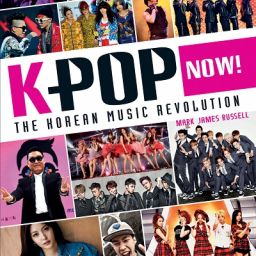by Miranda Ruth Larsen
K-pop as we know it simply isn’t possible without Japan. Dal Yong Jin contends that Japan is “the most significant foreign country for the Korean music industry” (117). The Japanese audience demonstrates their love of K-pop through sold-out arena concerts of artists like BIGBANG and CNBlue and the popularity of re-releasing Korean songs in Japanese versions, by artists like Twice, Girls Generation, BTS, and Block B.
Nevertheless, a large part of the K-pop industry involves rookie idols and their agencies, yet the digital saturation of global K-pop usually obscures their importance. Rookies mean any idol group who isn’t on contract with one of the big three agencies (SME, YG, JYP) or one of the handful of smaller agencies with regular presence on Korean music charts and TV programs (Cube, BigHit, and Loen Entertainment). Rookie idols are the ones that aren’t featured on iTunes splash pages, if their music is even available digitally at all outside of Korea. They’re often idols who trained at major agencies and were cut for one reason or another, men who decided to do their mandatory military service early — something that successful idol stars tend to postpone, or Korean citizen returnees that spent considerable time living abroad. While platforms exist for rookie groups in Korea, many of these idols are active in Japan, particularly Tokyo’s Koreatown of Shin-Okubo. While a handful of rookie girl groups have appeared in Shin-Okubo, most of the rookies there are male, so my discussion is focused on male idols.
One reason that Japan is a vital market for K-pop is the country’s focus on physical CD sales instead of Internet streaming and digital purchases, and Japan’s status as a vital receptor of the Korean Wave in all iterations (the early flood of K-drama, and the newer focus on K-pop). The interest in Korean culture manifests in the neighborhood of Shin-Okubo, situated in central Tokyo, which boasts winding streets crammed with Korean restaurants, K-beauty shops, stylish cafes blasting K-pop music videos, the bootleg merchandise of major idol groups, and groups of rookie idols performing every day to make a name for themselves.

Idols situated in Shin-Okubo tend to have their own original songs, but mostly perform covers of K-pop, Japanese, and English songs. The group I’ve conducted the most fieldwork with has a working setlist of over 150 songs including Boyz II Men, WINNER, Justin Timberlake, Japanese versions of TVXQ, and so on. This feeds the wider K-pop culture machine, as many fans subsequently purchase, watch the MVs, and learn the choreography of the K-pop songs. It also positions the idols as fans themselves, as they often discuss why they enjoy particular songs or choreography.
A typical Shin-Okubo concert costs between ¥2000 and ¥4500 in an extremely intimate venue. While concert tickets are a guaranteed revenue stream, most capital is generated from 特典会 (tokuten-kai), often translated as “benefits association privileges” or “benefits session” which are various interactions that occur after the concert.
Common benefits include:
チェキ (cheki) – a polaroid photo with one idol, or the entire group
セルカ (selca) – a selfie with the idol, or the entire group
個人サイン (koujin-sain) – one member’s autograph
団体サイン (dantai-sain) – autograph from the entire group
Rarer benefits include:
私物サイン (shibutsu-sain) – one member or all members autograph anything
動画 (douga) – a short video, roughly 30 seconds; sometimes taken together onstage, other times the fan’s phone is given to the idol to record a message to the fan backstage
5分デート(go pun de-to) – a 5 minute date with the idol in the venue or lobby, recorded on a cell phone
These benefits are purchased outright; one hands over ¥1000 and in exchange is given a selca ticket, or a glossy paper for an autograph. CDs are for sale and used for the group autographs, but are not counted towards any Japanese music chart.
After a concert finishes, the benefits session begins, often lasting an additional hour and a half. Aside from douga and 5 minute date, all of the other benefits take place in front of other fans and are facilitated by staff. Staff members take the polaroid photos, and linger around the table when the idols sign autographs in order to provide translations when fans and idols need help. After the benefits session the idols thank the fans for attending, pose for photo time lasting about one minute, and then either high touch or hugs are given as the attendees exit the venue. The images and video captured during photo time are then uploaded by fans on social media, frequently tagging the idols’ accounts or the group account, and circulate as both memory and promotion online.
After the last concert of the day fans then wait outside the venue for 出待ち(demachi) where the idols once again say goodbye and accept gifts. The schedules for these idols is usually crammed within a few months, often performing twice a day for up to three or four times per week. Since they live in dormitories (usually sharing rooms) and have challenges navigating Tokyo on their free days because of language, fans often present practical gifts at demachi: snacks, instant food, even alcohol.
Of course the idols aren’t alone in their venture to Japan: they’re supported, critically, by small agencies. Shin-Okubo agencies usually have affiliate offices in Tokyo and Korea, and multilingual staff as most of the rookie idols are still studying Japanese. While employee numbers vary from agency to agency, most employ a few specialized workers (hair and makeup, stylists, graphic designers) though many employees multitask. Other staff roles are centralized to the venues themselves, such as audiovisuals, which means the idols are constantly required to adjust and rehearse with different audio techs as they switch venues. Some staff members frequently work at a venue from early in the morning to late at night overseeing the concerts and benefits for three or four different performances of multiple groups. Fans often bring staff members similar practical gifts as the idols – snacks, candy, etc. – in recognition of their demanding schedules and the fact they have little chance to sit down and eat a proper meal.

While promotion of Shin-Okubo idol groups takes place on SNS like the major groups, most conduct “PR” by walking around Shin-Okubo with staff members and passing out small flyers emblazoned with their schedule. These flyers usually have the picture and name of each idol to provide information to potential fans, sometimes with biographical details in a small profile. The standard Shin-Okubo policy is attending a concert for the first time is either free or a very low price, such as ¥500 or ¥1000 yen, and including a free cheki or selca. From an industry standpoint this orientates new attendees to the system in the hopes of converting them into more dedicated fans that attend regularly. During PR fans accompany the idols and staff, often entreating curious passerby to come join them at the next concert, or snapping photos with professional cameras to upload later as publicity for the group.
Unlike larger groups with official Japanese fan clubs, Shin-Okubo idol groups usually operate on a point card system. Attending each concert usually equals one point (though there are double point days), and purchasing certain merchandise (such as towels or penlights/fanlights) earns extra points. Bringing along a friend for their first concert also earns an extra point, which cultivates fan labor. As the points accumulate various benefits are awarded, often culminating with a rare option like the 5 minute date (say, after 50 points).
As Roald Maliangkay has noted, part of K-pop’s appeal is a particular lifestyle. This is built into music videos, which “are not merely style indicators, but they also provide information on the singers’ lifestyle and allow fans to imagine how their idol would express his or her affection in a relationship” (96). In Shin-Okubo the industry cultivates a particular fandom lifestyle that is unmistakably enmeshed with the development of the rookie idols through shared intimacy and affect. A common lamenting joke among fans is that “the Shin-Okubo life is difficult,” often said when we’re complaining about not getting time to eat, just like the idols and staff. This is also said when showing a friend a wallet empty of cash but full of benefits tickets. A concert schedule is not a mere listing of dates, but a visible catalog of communal labor on the part of idols, staff, management, and fans. Because of this transparency, discussions about transcultural difficulties become commonplace: for example, the cancelling of a scheduled performance season immediately begins a discussion among fans about the challenges of obtaining a visa to enter and work in Japan.
A common sight in Shin-Okubo are idol groups huddled together as Japanese police check the validity of their visas. This emphasizes the precarity of the idols’ labor, the importance of the agency’s labor, and the power of the fans’ labor.
So how to further consider Shin-Okubo in the greater scheme of K-pop? If the Shin-Okubo idols are classified as rookies, then a middle category also exists – I call them ‘rising’ idols, the ones who appear on Korean music shows, have a presence and fanbase in Korea, yet aren’t on a major label. Rising idols are often far more popular in Japan than in Korea; they tend to sell their CDs through Tower Records Japan and hold promotional events that are theoretically free where the idols perform a handful of songs and chat briefly before the benefits session. It should be noted, however, that the categories aren’t mutually exclusive: rookies and rising idols often overlap. At one point a group was conducting concerts in Shin-Okubo but promotional events at Tower Records, crisscrossing Tokyo on a daily basis. The critical change necessitating two different categories is how the benefits model is aggressively streamlined for rising idols:
拍手 (hakushuu) – shaking hands with the entire idol group
サイン (sain) – one idol signs a CD or a standardized pasteboard for the fan; the fan must write their name and can also write a brief question on a note memo for the idol to reference
2ショットセルカ (2 shot selca) – a selfie with the idol, the ‘2’ emphasizing only 2 photos are supposed to be taken
At this level the staff act as enforcers and gatekeepers; instead of handing one’s phone to the idol, the fan hands it to the staff member who checks that it is not in video mode and that Live Photo is off in the case of iPhones. Staff tend not to interpret for fans at all, and only interpret for the idol if the idol requests it. The rules for photos are stricter here, delineated in fine print on the back of a special ticket; since a fan is not supposed to initiate physical contact with the idol or request a pose, staff closely monitor each interaction. Labor becomes more specialized at this level, reinforcing hierarchies of access and obvious control over affective interactions.
For rising idols, benefit tickets are obtained by purchasing or pre-ordering CDs from Tower Records, with certain CD editions equalling a certain amount of tickets. This has a very obvious function:

the more benefits fans covet, the more tickets needed, the more CDs purchased – and the higher the chance the CD will earn a place on Oricon, the Japanese equivalent to Billboard Music Rankings. The price point is therefore much higher, averaging around ¥2500 per CD that comes with one benefit ticket; three tickets are needed for a photograph, meaning fans shell out ¥7500 for taking a picture.
Besides the obvious financial cost, the industry around rising idols requires a large investment of time. The free performances associated with these events have a priority area where fans may stand, and entrance to the priority area is based on a random number ticket. To put it plainly, for an event at 1PM, number tickets are handed out on a first-come-first-served basis at 11AM, meaning many fans camp out overnight or as early as 4AM in order to be first in line even though the numbers are supposed to be random. The free event usually has at least one song that may be recorded and photographed, so earning a low number is prized for those that want to record the idols and upload to SNS.
At this year’s KCON LA, I participated in the Cultural Clashes in Hallyu panel. When asked what fans could do to make their voices heard about things in K-pop that elicit strong reactions, I advised that fans support rookie groups. In an industry predicated on music charts and fan club memberships, and dominated by the sophisticated factories of JYP, YG, and SM Entertainment, the rookie level is one of the only times where fan voices directly reaches an idol. While it may not always be the case, this can shape the future direction of that idol’s career. By the time an idol reaches one of the major labels and is made easily available via iTunes, they are distanced (whether they like it or not) by the industry and agencies to extremely regulated interactions with fans.
K-pop is a “comeback” culture that demands a high input of labor for an unwieldy output of revenue. K-pop’s global popularity is tied to digital availability, yet that availability is often limited to music sales, merchandise purchases, social media activity, and fan works. Many of these activities address a gap in intimacy that cannot be answered by an impromptu V Live. Shin-Okubo is a training ground for idols and industry members that offers almost unprecedented levels of intimacy. As I will further discuss in my next TLF piece about Shin-Okubo, certain spaces make the labor of K-pop visible. Most idols that debut in Korea fail; many idols who work the Shin-Okubo circuit also fail. Some try again with a different agency, or leave the industry altogether. But a good number become dance and vocal trainers, stylists, staff members, or other support positions within the K-pop industry.
With BTS’ recent appearance at the American Music Awards, the announcement at MAMA 2017 in Japan of Produce48 starting next year, and many other happenings, K-pop and K-pop fandom is pushing for even greater visibility on a global scale, and more importantly, greater visibility of the inherently global nature of K-pop itself. Yet most of the focus remains on popular groups from the top agencies in Korea, or fledgling groups supported with great publicity on reality television programs. While focus on prominent idols is important, much of what sustains the transcultural K-pop machine occurs on the streets, face to face. Shin-Okubo agencies know that SNS is a useful tool, but that effective (and affective) connection happens when an idol hands a flyer to a prospective fan on the street, or a current fan brings a friend along for their first show.
Miranda Ruth Larsen is a PhD candidate at the University of Tokyo. Her research focuses on the transcultural appeals of masculinities in Japanese and Korean popular music. She has been tinkering with the V app since its debut at KCON 2015. She previously wrote for TLF’s Seminar Series about the Japanese boy group KAT-TUN and the V-Live App
Works Cited
Jin, Dal Yong. New Korean Wave: Transnational Cultural Power in the Age of Social Media. Chicago: University of Illinois Press, 2016.
Maliangkay, Roald. “Uniformity and Nonconformity: The Packing of Korean Girl Groups.” Hallyu 2.0: The Korean Wave in the Age of Social Media, eds. Sangjoon Lee and Abe Mark Nornes. Detroit: University of Michigan Press, 2015.




